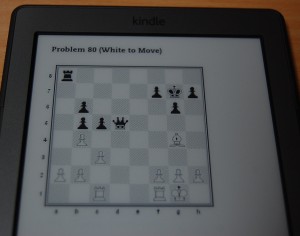I have been working with a couple of Kindle chess books recently. Back in the summer I had accumulated enough “Member Rewards Points” on the Tripleclicks website to reward myself with a free Kindle Touch with the intention taking it with me on our summer holiday.
For some reason, however, I didn’t get around to using it until September, when I bought the Kindle versions of Hilary Mantel‘s Wolf Hall and Bring Up The Bodies, two novels in what is expected to be a trilogy about the life of Thomas Cromwell.
I doubt that I shall get around to reviewing those two books although I would like to. However, they have been amply reviewed elsewhere, and James Wood’s review in the New Yorker explains what there is to appreciate about the novels, in spite of their occasional infelicities of prose style.
Once I started using my Kindle I was quickly hooked. It is ideal for reading on public transport, and is just as convenient for bedtime reading (although right now for bedtime reading I am ploughing through the Folio Society edition of G. R. Elton‘s England Under the Tudors ).
Apart from that, I am continuing to read and study The Amateur’s Mind: Turning Chess Misconceptions into Chess Mastery by Jeremy Silman.
The author is a natural teacher as well as an excellent chess master; the two are not often found together. Silman explains certain concepts and shows an example of the concept in play using actual games. He then sits down with one of his students and plays through the same game to see how they respond. As we read along, we can see the student gradually screwing up the situation or, in some cases, coping well, and we learn from the contrast between what Silman has taught and what the student is doing, as well as from Silman‘s commentary about what the student is and ought to be doing.
T. E. Klemm and his Kindle Chess Books
The Amateur’s Mind is so illuminating that I wanted to buy the Kindle version of another of Silman‘s books, Reassess Your Chess. Unfortunately, it is not one of Silman’s Kindle chess books, so I bought 100 Chess Problems for the Rest of Us by T. E. Klemm instead. I’ve been “reading it” on the tram and train ever since, although I will most likely finish it tomorrow. After that, I will definitely get the next volume because I agree with the author’s assessment of the book:
Of course, those in the 1600-1700 range will be able to solve most (if not all) these problems with relative ease. However, I am a firm believer – as are many – that these basic problems are akin to the routine, rudimentary practice drills professional sports athletes engage in everyday. Just as basketball players spend hours of their week practicing the basics free throw shot, or as third basemen spend hours making the same routine throws to first base, chess players need to routinely engage in the most rudimentary of problems to stay on top of their game.
Most of the problems can be solved in less than a minute, and I have got about 90% right first time. Some are immediately obvious to me, others not so. In most cases the solution results in either Checkmate or a decisive advantage for the player that moved first in the problem.
However, a few of the problems have solutions which allow for the other side to limit the damage done by the trap into which he fell, as, I think, is the case with this skewer:
 The solution to this fairly basic problem is to move White’s Bishop to f3 and skewer Black’s Queen and Rook.
The solution to this fairly basic problem is to move White’s Bishop to f3 and skewer Black’s Queen and Rook.
In the solution Klemm explains that “Black will lose its Rook.” This is perfectly true, and whatever happens, White will have gained material, but it is not really such a disaster for Black because he take the Pawn on a2 with his Queen, and then when the Bisop takes the Rook, the Queen can take the Bishop:
B f3, Q x a2
B x a8, Q x a8
The endgame arrives, with 6 Pawns each, and two Rooks versus a Queen, which leaves the advantage unclear.
That is just a quibble. As Kindle chess books go, what I like about Klemm’s two chess problem books is that they seem ideal for the Kindle book format.
DH
